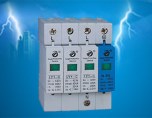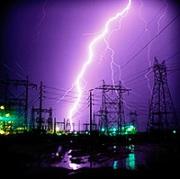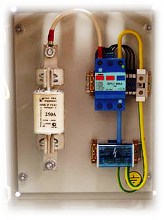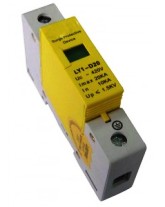Surge protection devices
 Classification and application of SPD
Classification and application of SPD
Power line surges can be caused by a variety of reasons. For example, lightning storms, overlapping wires, eddy currents when switching on and off a reactive load, breakdowns and repairs, etc.
There is a special class of devices for the protection of home electricity and electronics. Devices of this type are called in two ways: surge protection devices (SPD) or surge protection devices (OPS).
How to protect yourself?
For reliable protection of home wiring, it is necessary to build a multi-level (at least three-level) SPD protection system of different classes. Their use is regulated by GOST R 51992-2002 (IEC 61643-1-98). According to this GOST, there are three classes of such devices.
Class I (B) SPD
 Designed to protect against direct lightning strikes construction of a lightning protection system or overhead power line… Installed at the building entrance in the Entrance Switchgear (ASU) or Main Switchboard (MSB). Standardized by impulse current I imp with waveform 10/350 μs. Rated discharge current 30-60 kA.
Designed to protect against direct lightning strikes construction of a lightning protection system or overhead power line… Installed at the building entrance in the Entrance Switchgear (ASU) or Main Switchboard (MSB). Standardized by impulse current I imp with waveform 10/350 μs. Rated discharge current 30-60 kA.
Class II (C) SPD
Such surge protection devices are designed to protect the facility's power distribution network from disruptive interference or as a second stage of protection in the event of a lightning strike. Installed in switchboards. They are standardized by a pulsed current with an 8/20 μs waveform. The rated discharge current is 20-40 kA.
Class III (D) SPD
Such devices for protection against impulse overvoltages Designed to protect users from residual voltage surges, protection against differential (asymmetric) overvoltages (for example, between phase and neutral wire in a TN-S system), filtering of high-frequency interference.
Installed directly near the user. They can have a wide variety of designs (in the form of sockets, plugs, individual modules for mounting on a DIN rail or surface mounting). They are standardized by a pulsed current with an 8/20 μs waveform. Rated discharge current 5-10 kA.
SPD device
 Surge protective devices (SPDs) are built around limiters or varistors and often have indicating devices that signal SPD failure. The disadvantage of varistor-based SPDs is that, once triggered, they must cool down to return to operating condition. This worsens the protection against repeated lightning strikes.
Surge protective devices (SPDs) are built around limiters or varistors and often have indicating devices that signal SPD failure. The disadvantage of varistor-based SPDs is that, once triggered, they must cool down to return to operating condition. This worsens the protection against repeated lightning strikes.
Varistor — a semiconductor non-linear resistor, the principle of which is based on a decrease in resistance with an increase in the applied voltage. Look - principle of operation and application of varistors.
Typically, varistor-based SPDs are manufactured with DIN rail mounting. A blown varistor can be replaced by simply removing the module from the SPD box and installing a new one.
SPD application practice
To reliably protect an object from the effects of overvoltage, first of all, it is necessary to create it efficiently grounding system and equalization of potential. In this case, you should switch to grounding systems TN-S or TN-CS with separated neutral and protective conductors.
 The next step is to install security devices. When installing the SPD, it is necessary that the distance between adjacent protective steps be at least 10 meters along the power cable. The fulfillment of this requirement is very important for the correct sequence of operation of the protective devices.
The next step is to install security devices. When installing the SPD, it is necessary that the distance between adjacent protective steps be at least 10 meters along the power cable. The fulfillment of this requirement is very important for the correct sequence of operation of the protective devices.
If an overhead line is used for connection, it is better to use SPD based on arresters and fuses in the pole entrance panel. Class I or II varistor SPDs are installed in the main board of the building, and Class III SPDs are installed in the floor shields. If it is necessary to additionally protect the equipment, then SPDs in the form of inserts and extension cables are connected to the sockets.
conclusions
In conclusion, it must be said that all the above measures, of course, reduce the likelihood of injury to CEA and people from increased stress, but they are not a panacea. Therefore, in the event of a thunderstorm, it is better to turn off the most critical nodes if possible.
